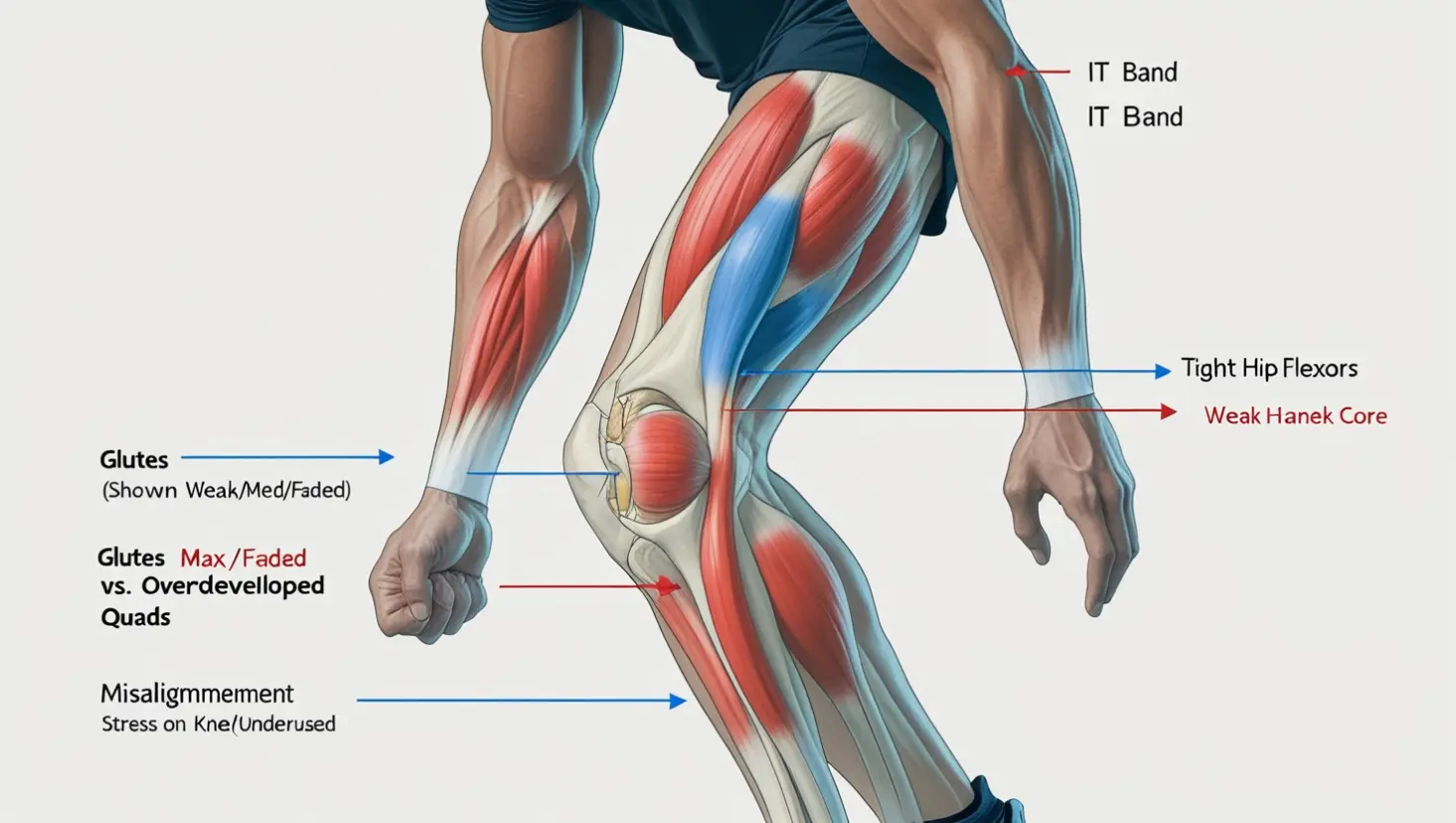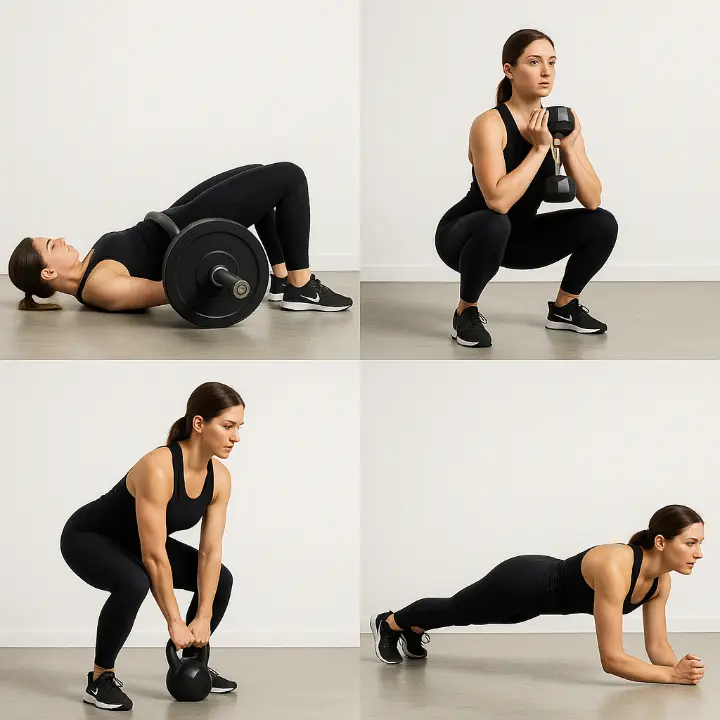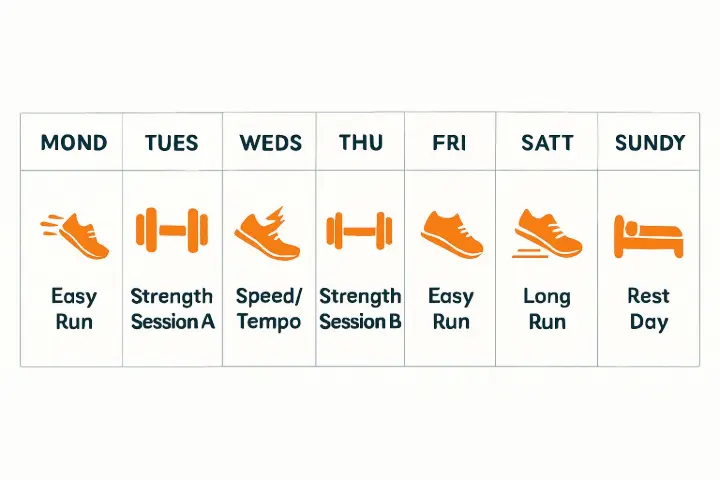Picture this: You're dedicated. You log miles religiously, track your pace, maybe even dabble in interval work. Yet, progress plateaus. Niggling aches – a cranky knee here, a tight hip there – start becoming unwelcome regulars on your runs. Or perhaps you dream of that finishing kick, that effortless power up a hill, but it feels just out of reach. What if the missing piece wasn't more running, but something happening off the road?
Welcome to the transformative world of strength training for runners. Forget the bulky bodybuilder stereotype. This isn't about vanity; it's about building a more robust, resilient, and powerful running machine – your body. It's the difference between a car with a strong engine but a flimsy chassis and a high-performance vehicle built for endurance and speed.
Why Your Running Shoes Aren't Enough: The Compelling Case for Strength
Let's bust the biggest myth first: "Running makes me strong enough for running." While running builds incredible cardiovascular fitness and leg endurance in a very specific way, it's a repetitive motion in a single plane (forward). It creates muscle imbalances, neglects crucial stabilizing muscles, and offers little resistance to truly build maximal strength or power.

Here’s what happens without strength work:
Muscle Imbalances Run Rampant: Dominant quads overpower weaker glutes and hamstrings. Tight hip flexors pull against weak core muscles. This pulls joints out of alignment – hello, IT band syndrome, runner's knee, shin splints.
Efficiency Suffers: Weak muscles can't effectively absorb impact or propel you forward powerfully. You waste energy with every stride. Studies, like one published in the Journal of Strength and Conditioning Research, have shown strength training can improve running economy (how much oxygen you use at a given pace) by 2-8%. That translates directly to faster times or easier efforts.
Power is Missing: That explosive push-off needed for a sprint finish or conquering a steep hill? It comes from maximal strength and power, developed through lifting, not just mileage.
Injury Risk Skyrockets: Weak muscles mean tendons and ligaments take on more stress than they're designed for. Research consistently shows strength training reduces running-related injuries. A landmark review in the British Journal of Sports Medicine concluded it can lower injury risk by up to 50%. Think about that – half as likely to get sidelined!
What Kind of Strength Are We Talking About? (It's Not Bodybuilding!)
For runners, strength training is strategic. We focus on:
Maximal Strength: Building the peak force your muscles can produce. This is your foundation. Think heavy(ish) squats, deadlifts, lunges – done with good form, focusing on controlled movement. You won't get "bulky" from 2-3 sessions a week; you'll get stronger and more resilient.
Power: The ability to produce force quickly. This is crucial for acceleration, hill climbing, and stride efficiency. Plyometrics (jump training) and explosive lifts (like kettlebell swings or jump squats) build this.
Muscular Endurance: The ability of muscles to sustain force over time (like holding good form late in a long run). Higher-rep sets or bodyweight circuits target this.
Stability & Balance: Strengthening the deep core muscles and small stabilizers around joints (hips, ankles, knees) to keep everything aligned and moving smoothly. This is where exercises like planks, Pallof presses, and single-leg work shine.
The Runner's Strength Blueprint: Key Exercises & Muscle Groups
Think of your body as a suspension bridge. Your core is the central tower, your glutes and hips are the foundational supports, and your legs are the cables transmitting force. Strengthen the whole structure.

The Powerhouse: Glutes & Hips
Why: The glutes (maximus, medius, minimus) are your primary hip extensors and stabilizers. Weak glutes are Public Enemy #1 for runners, contributing to countless injuries.
Exercises:
Hip Thrusts/Glute Bridges: The king/queen of glute activation. Start with bodyweight, progress to barbell or band resistance. Focus on squeezing at the top.
Step-Ups: Mimics the running stride. Keep torso upright, drive through the heel of the working leg. Add weight for challenge.
Lunges (Forward, Reverse, Walking): Builds single-leg strength and stability. Ensure front knee tracks over ankle, doesn't cave inward. Dumbbells add load.
Clamshells & Banded Walks: Target the often-neglected glute medius for hip stability. Essential for preventing knee valgus (knee collapse inward).
The Pillar: Core
Why: Not just about "six-pack" abs. A strong core (abs, obliques, lower back, pelvic floor) acts as a stable platform, transferring force between upper and lower body efficiently and preventing wasteful rotational movement. It keeps you upright and controlled, especially when fatigued.
Exercises:
Planks & Side Planks: Build anti-extension and anti-rotation stability. Hold with perfect form (no sagging hips!). Progress by adding time or instability (e.g., feet on a stability ball).
Dead Bugs & Bird Dogs: Teach core control while moving limbs, mimicking the running pattern without impact. Focus on keeping your lower back pressed firmly to the floor (Dead Bug) or maintaining a neutral spine (Bird Dog).
Pallof Press: Excellent anti-rotation exercise. Resist the pull of a cable or band trying to twist your torso.

The Springs: Quads & Hamstrings
Why: Quads extend the knee for propulsion and absorb landing impact. Hamstrings help extend the hip and flex the knee (crucial for the recovery phase of your stride). Balance is key here!
Exercises:
Squats (Goblet, Back, Front): The ultimate lower-body strengthener. Goblet squats are fantastic for beginners to learn proper depth and posture. Focus on depth (thighs parallel to floor or lower) and driving knees out.
Romanian Deadlifts (RDLs): Master the hip hinge! Targets hamstrings and glutes while teaching posterior chain engagement. Keep a slight knee bend, back straight, push hips back. Feel the stretch in the hamstrings.
Nordic Hamstring Curls: The gold standard for eccentric hamstring strength (strengthening while lengthening), crucial for injury prevention (especially hamstring strains). Start assisted if needed.
The Connectors: Calves & Ankles
Why: Absorb massive impact forces with every stride and provide the final "push-off." Strong, resilient calves and stable ankles prevent Achilles issues and shin splints.
Exercises:
Calf Raises (Double & Single Leg): Simple but effective. Do them slowly, focusing on the full range of motion (deep stretch at the bottom, full contraction at the top). Add weight or do them off a step for a deeper stretch.
Heel Walks & Toe Walks: Great for tibialis anterior (front shin) and calf strength/endurance.
Single-Leg Balance Progressions: Start on flat ground, progress to unstable surfaces (foam pad, folded towel) or with eyes closed. Add arm movements or light knee bends.
Putting it Together: Your Weekly Strength Plan
How does this fit into your running schedule? Consistency beats intensity. Aim for 2-3 strength sessions per week, ideally on easy run days or rest days. Never do a hard strength session the day before a key speed workout or long run – fatigue compromises form and running performance.

Sample Structure (45-60 minutes):
Warm-up (5-10 mins): Light cardio (jog, bike, row) + dynamic mobility (leg swings, arm circles, cat-cow, walking lunges with twist).
Main Strength (30-40 mins): Choose 4-6 compound exercises covering the key muscle groups.
Example Session A: Goblet Squats, Hip Thrusts, Romanian Deadlifts, Plank (3 sets), Single-Leg Calf Raises.
Example Session B: Step-Ups, Glute Bridges (with band), Dead Bugs, Pallof Press, Nordic Curl Progressions.
Plyometrics/Power (Optional, 5-10 mins): After strength, when fresh. E.g., Box jumps (low height, focus on quick rebound), Medicine Ball Slams, Skipping A-Skips/B-Skips. Start with low volume (2-3 sets of 5-8 reps).
Cool-down (5 mins): Static stretching (hold 30 secs) for tight areas like hip flexors, hamstrings, calves.
Sets & Reps:
Max Strength Focus: 3-4 sets of 4-8 reps with heavier weight (challenging but allowing perfect form).
Hypertrophy/Muscular Endurance: 2-3 sets of 8-15 reps with moderate weight.
Stability/Balance: 2-3 sets of 12-20 reps or timed holds (30-60 secs) using bodyweight or light resistance.
Progressive Overload is Key: Gradually increase the weight, reps, sets, or difficulty over weeks and months to keep making gains.
Real Talk: Common Concerns & Expert Insights
"Won't I get bulky and slower?" Highly unlikely. The volume and type of lifting runners do promotes strength and lean muscle without significant size gain. As elite running coach Jay Johnson often says, "Strength is never a weakness." That extra power translates directly to speed. Marathon legend Eliud Kipchoge famously incorporates strength work into his regimen.
"I don't have time!" Even 20-30 minutes, twice a week, focusing on key compound movements (squats, hip thrusts, core) is infinitely better than nothing. Think of it as essential maintenance, like changing your running shoes.
"Where do I start? I'm intimidated by the gym." Perfectly valid! Start with bodyweight exercises at home: lunges, squats, glute bridges, planks, step-ups on a sturdy chair. Master form first. Consider a session or two with a certified trainer (look for someone experienced with runners) to learn the ropes. Online resources with reputable coaches (like RunnersConnect or Strength Running) offer great form videos and beginner plans.
Listen to Your Body: Some muscle soreness (DOMS) is normal, especially when starting. Sharp pain is not. Don't push through joint pain. Modify exercises as needed. Dr. Jordan Metzl, a renowned sports medicine physician and Ironman triathlete, emphasizes, "Strength training isn't about pain; it's about building armor."

The Finish Line: Stronger, Faster, Further
Strength training isn't a detour from your running journey; it's an upgrade to the very engine propelling you forward. It's the investment that pays dividends in injury resilience, letting you train consistently without frustrating setbacks. It's the hidden reservoir of power that fuels your kick, powers you up hills, and makes your regular pace feel effortless. It’s about building a body that doesn't just endure the miles but thrives through them.
So, lace up your running shoes, but don't forget to pick up those weights or use your own body as resistance. Embrace the strength. Your future, faster, more robust running self will thank you for it. Now, get out there and build that running machine!
